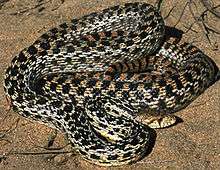Pituophis
| Pituophis | |
|---|---|
 | |
| San Diego gopher snake Pituophis catenifer annectens | |
| Scientific classification | |
| Kingdom: | Animalia |
| Phylum: | Chordata |
| Subphylum: | Vertebrata |
| Class: | Reptilia |
| Order: | Squamata |
| Suborder: | Serpentes |
| Family: | Colubridae |
| Subfamily: | Colubrinae |
| Tribe: | Lampropeltini |
| Genus: | Pituophis Holbrook, 1842 |
| Synonyms | |
|
Arizona, Churchilla, Coluber, Elaphis, Epiglottophis, Pityophis, Rhinechis, Spilotes[1] | |
Pituophis is a genus of nonvenomous colubrid snakes commonly referred to as gopher snakes, pine snakes, and bull snakes, which are endemic to North America.
Geographic range
Species within the genus are found throughout the western and southern United States and in Mexico.[2]
Description
All species of Pituophis are large and powerfully built. The head is relatively small in proportion to the body, and it is only slightly distinct from the neck. The rostral is enlarged and elongated, imparting a characteristic somewhat pointed shape to the head. All the species occurring in the United States have 4 prefrontals instead of the usual 2.[2]
Modified epiglottis
In all snakes of the genus Pituophis the epiglottis is peculiarly modified so that it is thin, erect, and flexible. When a stream of air is forced from the trachea, the epiglottis vibrates, thereby producing the peculiarly loud, hoarse hissing for which bull snakes, gopher snakes, and pine snakes are well known.[3]
Species
- Pituophis catenifer (Blainville, 1835) - gopher snake
- Pituophis catenifer affinis (Hallowell, 1852) - Sonoran gopher snake
- Pituophis catenifer annectens Baird & Girard, 1853 - San Diego gopher snake
- Pituophis catenifer bimaris Klauber, 1946 - central Baja California gopher snake
- Pituophis catenifer catenifer (Blainville, 1835) - Pacific gopher snake
- Pituophis catenifer coronalis Klauber, 1946 - Coronado Island gopher snake
- Pituophis catenifer deserticola Stejneger, 1893 - Great Basin gopher snake
- Pituophis catenifer fulginatus Klauber, 1946 - San Martin Island gopher snake
- Pituophis catenifer insulanus Klauber, 1946 - Credos Island gopher snake
- Pituophis catenifer pumilis Klauber, 1946 - Santa Cruz gopher snake
- Pituophis catenifer sayi (Schlegel, 1837) - bull snake
- Pituophis catenifer vertebralis (Blainville, 1835) - Cape gopher snake
- Pituophis deppei (A.M.C. Duméril, 1853) - Mexican pine snake
- Pituophis deppei deppei (A.M.C. Duméril, 1853) - Mexican pine snake
- Pituophis deppei jani (Cope, 1861) - northern Mexican pine snake
- Pituophis lineaticollis (Cope, 1861) - Middle American gopher snake
- Pituophis lineaticollis gibsoni Stuart, 1954
- Pituophis lineaticollis lineaticollis (Cope, 1861)
- Pituophis melanoleucus (Daudin, 1803) - pine snake
- Pituophis melanoleucus lodingi Blanchard, 1924 - black pine snake
- Pituophis melanoleucus melanoleucus (Daudin, 1803) - northern pine snake
- Pituophis melanoleucus mugitus Barbour, 1921 - Florida pine snake
- Pituophis ruthveni Stull, 1929 - Louisiana pine snake
References
- ↑ Wright, A.H., & A.A. Wright. 1957. Handbook of Snakes of the United States and Canada. Comstock. Ithaca and London. 1,105 pp. (in 2 volumes) (Pituophis, pp. 585-626, Figures 171.-181., Map 46.)
- 1 2 Conant, R. 1975. A Field Guide to Reptiles and Amphibians of Eastern and Central North America, Second Edition. Houghton Mifflin. Boston. 429 pp. ISBN 0-395-19977-8 (paperback). (Genus Pituophis, pp. 198-201 + Plate 27 + figure 57 + Map 147.)
- ↑ Schmidt, K.P., and D.D. Davis. 1941. Field Book of Snakes of the United States and Canada. G.P. Putnam's Sons. New York. 365 pp. (Genus Pituophis, pp. 158-160.)
Further reading
- Holbrook, J.E. 1842. North American Herpetology; or, A Description of the Reptiles Inhabiting the United States. Vol. IV. J. Dobson. Philadelphia.
138 pp., 35 plates. (Genus Pituophis, p. 7.)
External links
- Genus Pituophis at The Reptile Database
- Accounts of four subspecies, P. deppei deppei, P. deppei jani, P. lineaticollis lineaticollis, and P. lineaticollis gibsoni, are given in Duellman, William E. 1960. A Taxonomic Study of the Middle American Snake, Pituophis deppei. University of Kansas Publications, Museum of Natural History 10 (10): 599-610.